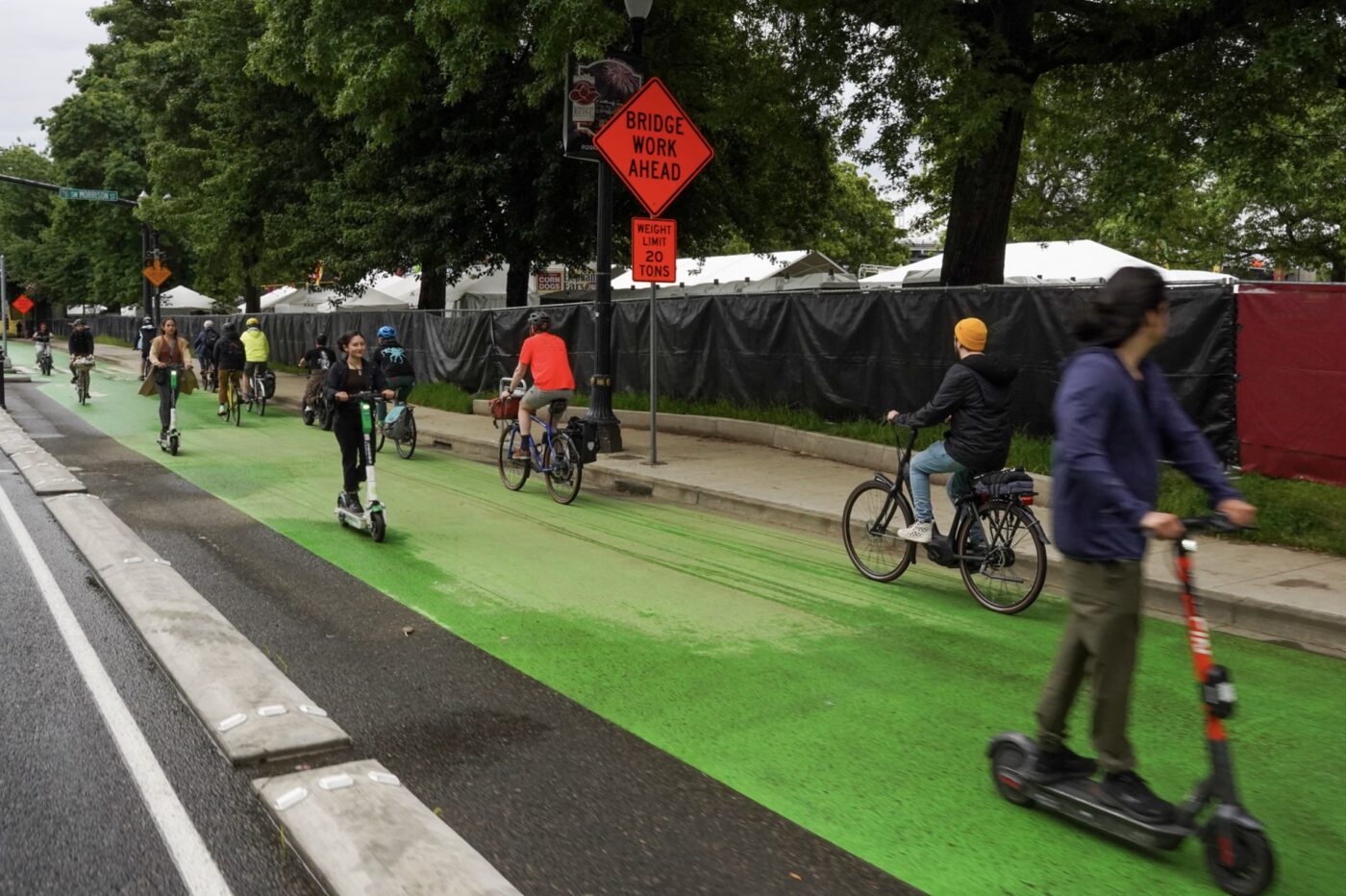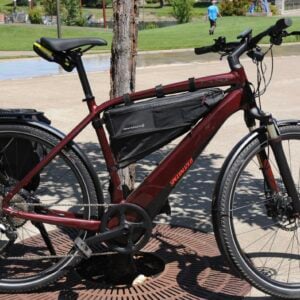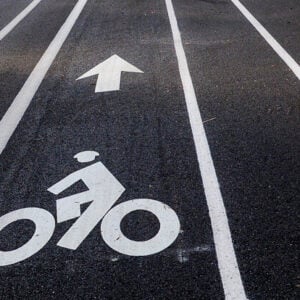
Oregon Senator Floyd Prozanski plans to withdraw a controversial bill that would have banned a popular type of electric-assisted bicycle from bike lanes and paths.
Advocates with The Street Trust met with Sen. Prozanski on Friday and they say he’s agreed to drop the bill.
Senate Bill 471 caught cycling and safe street advocates by surprise when it was introduced last month. It sought to prohibit Class 3 electric bicycles from bike-specific infrastructure and would have made them legally akin to mopeds and motorcycles. Class 3 e-bikes have no throttle, can have maximum speed of 28 mph (from the motor) and the motor only works when the rider is pedaling.
In an interview with BikePortland in January, Prozanski said he and his riding buddies saw many people riding motorized vehicles (which may or may not have been e-bikes) on bike paths without regard for Oregon law or for the safety of others. He then acknowledged the use of “Class 3” in the bill language was incorrect.
Local nonprofit advocacy organization The Street Trust (TST) published an article earlier this month that said Prozanski’s bill threatens, “to saddle e-bikes with unnecessary restrictions rather than advancing policies that make streets safer.”
Here’s more from The Street Trust’s article:
Instead of reactionary regulations, Oregon must implement expert-driven policies developed by stakeholders across sectors — public agencies, industry leaders, and community advocates who understand the realities of how people move using small things with wheels, aka micromobility.
The regulatory focus should be on operator behavior and vehicle speed in shared spaces, and avoiding arbitrary restrictions based on vehicle type which are hard to discern, let alone enforce.
We need clear, enforceable rules that ensure e-scooters and e-bikes remain accessible, while protecting riders and other road users from the risks of higher-speed motorcycles, mopeds, and illegally modified “e-bikes”.
The article was written by Cameron Bennett, a TST board member and policy lead for the group’s Oregon Micromobility Network project. Bennett was also at the meeting with Senator Prozanski last week where they discussed concerns about the proposed legislation.
In a phone call with BikePortland today, Bennett said Prozanski has agreed to they are happy with the outcome now that the bill will not move forward. “We’re excited to have the Senator’s support in our ongoing education efforts around e-bikes, instead of working against us,” Bennett said.
This isn’t the first time Senator Prozanski has proposed a bike-related bill that was ultimately withdrawn after widespread criticism. In 2008 he filed a bill that would have made Oregon’s helmet law apply to all ages of riders. That bill met with fierce opposition from cycling advocates and Prozanski scrapped it a few weeks after it appeared on BikePortland.






Thanks for reading.
BikePortland has served this community with independent community journalism since 2005. We rely on subscriptions from readers like you to survive. Your financial support is vital in keeping this valuable resource alive and well.
Please subscribe today to strengthen and expand our work.
Good move! (to withdraw the bill). But it’ll be back – right after some dude going 30 mph on an e-bike kills an old lady.
Next time get some expert advice from the cycling community before mooting a bill.
Cool, then let’s ban cars and trucks
Problem is that the “cycling advocates”– who are actually social justice and climate advocates first, cycling maybe a distant third priority– will drown out the opinions of people who actually ride bikes, and the conversation will become a mess of identity politics and cringeworthy anti-capitalist rhetoric.
I don’t share your pessimism, Jordan. People can do more than one thing at a time.
In this case, that luckily didn’t happen!
Or.. we could regulate the speed instead of the much harder to detect settings or class of an ebike.
I’ve seen this a lot, and its not quite true for a lot of class 3 ebikes (fuzzy definition, state by state, etc).
Many Class 3 ebikes do have a throttle, however it only propels the bike to 20 mph.
In order to go past 20 and up to 28 mph, you must pedal assist.
Frankly this seems like a better classification to me, it seems weird that a class 3 has less features than a class 2..
And many of those throttled class 3 bikes can very very easily be modified to eliminate that restriction, allowing them to achieve 28mph or higher on throttle only.
The Class system is nonsensical when we are trying to classify bikes based on easily modified attributes. Maybe we should classify them based on weight and motor size instead?
Yep power and cut off speeds and just software settings easily changed often wirelessly from a phone even.
Motor size? Like measuring the physical size of the motor?
If one adds a throttle to a “Class 3” bike, it becomes “not a Class 3 bike”. We’ve all seen a very fast bike-looking object with a throttle, but these would be outside the class system as currently defined.
It would be intuitive to assume that the fastest, most motorcycle-like e-bikes are Class 3, because 3 is the largest number in the classification system. However, while Class 2 bikes are allowed to have throttle, Class 3 bikes are not.
It’s great that manufacturers can be creative with their products, but if the bike you describe is sold as either Class 2 or Class 3, that would seem to be not in compliance with a plain reading of the current Class system. The bike may very well be a legal consumer product, but it wouldn’t be correct to regulate it *as a Class 3 e-bike*. It would also be confusing and incorrect to refer to bikes like this one as an example of the reason “Class 3 e-bikes” should be regulated more seriously.
These comment threads are infuriatingly confusing, and illustrate one of the main problems with this kind of regulation.
Class 3’s don’t have throttles. Class 2’s have throttles and can be hacked to go over 20MPH.
Many bikes are being sold as Class 2/Class 3. They include a throttle limited to 20mph and pedal assist to 28mph, and of course are easily hacked to be full throttle assist with no speed limit at all.
Yea or some bikes are sold as class 3 but with an uninstalled optional throttle that’s plug in play.
Sounds like Farley’s kind of senator. Shame on them.
Gas powered mopeds that go 30mph aren’t allowed in our bicycle facilities, so I don’t know why vehicles that are essentially the same but electric powered should be allowed either.
This conflict will only continue as long as “cycling advocates” continue to simp for the electric motorcycle industry.
Jordan,
Ten years ago I was in the “anti-e-bike camp.” There was no valid reason to own one. I commuted for years day and night and in the rain. I rode multiple centuries. I rode the STP in one day. I rode across the country unsupported.
I’m in my mid 70’s and am not as strong as I was. I bought an e-bike to continue to ride with my friends. I use the electric assist sparingly – mostly on the hills. I don’t think you would even notice if you and I were on a group ride.
At the lowest power setting the e-bike motor gives me an assist of about 3 mph. At the highest a boost of about 9 mph. I have to pedal to get any assist. It is NOT an electric motorcycle.
If I’m not allowed on bicycle facilities, as you propose, I would be required to “take the lane” on Ross Island Bridge or Hawthorne or Burnside or Morrison to get downtown. Does that make any sense at all?
Maybe you will think differently in 40 or 50 years.
I’m 43 and I agree wholeheartedly!
Agreed J_R I got to go on a multiday bicycle tour with my 80 year old above the knee amputee father last year because of e-bikes, they are awesome and purists will have some difficulty convincing me otherwise.
Can we all agree to the following?
1. E-bikes that function more-or-less as a normal bike, enabling folks to keep up with others or go a little further, are fine.
2. Riding a heavy e-bike at speed on sidewalks or narrow bike paths can be a problem.
Let’s focus on how to solve problem #2 without losing the benefits of #1.
There’s a legitimate issue with how some folks ride. No one takes issue with the moderate users.
I’d sign on to that resolution.
E-bikes are mopeds by definition and should be required to be licensed and insured like any motor vehicle.
Do you have any actuarial statistics to justify that kind of regulatory hammer? Are you seeing crashes, injuries, and fatalities on par with motor vehicles?
My e-bike and I weigh about 190 pounds. Does physics offer some non-intuitive justification for regulating my e-bike like my 4,000 lb pickup?
I can understand that the user experience on multi-use paths has changed since the widespread adoption of e-bikes. That might necessitate *some* kind of change to regulations, but licenses and insurance wouldn’t have any effect on that situation.
JM’s and BP’s position is tantamount to saying Teslas and Rivians need not be licensed and insured because they are powered by electric motors rather than by internal combustion engines.
Of course you are under no obligation to answer the questions I’ve asked.
However, I do believe that your response betrays the low strength of your argument.
Want to echo that it’s not the worst idea to classify 2-wheeled electric motor vehicles, it’s probably best done with sensible criteria such as weight and power (wattage I believe?). Or perhaps three base tiers of (1) ebike – has pedal assistance without throttle (2) emoped – has a throttle and is low-powered (less than x weight and y power), may or may not have pedal assistance. (3) emotorcycle – had a throttle, is above a specific weight and power, without pedal assistance. Then you could create sub-classifications and so on..
One things for sure, some needs to clean up the language surrounding these vehicles.
Your categories don’t really address work bikes and multi passenger bikes. A person might say that since they are heavier they should be regulated as mopeds or above. However the power to weight ratio seems like the important thing to look at since a loaded bike with a biggish motor performs in the same envelope as a smaller ebike in your class 1.
A loaded ebike using electric assistance will often be passed by just bikes, whether because the ebike rider is cruising to stretch out battery life or because some more able riders delight in passing anything with a motor on it, a feeling that I understand. One reason that I hesitated to switch to an ebike was the knowledge that when the battery is dead an ebike goes pretty deeply into the lesser-than category.
As it has happened, I’ve only once had the controller on my ebike shut down because of low charge in the battery, and that was just a few blocks from home. There’s a strong financial incentive for ebike owners to moderate battery use since it’s recommended to keep charge levels in the 20 to 80% range and battery replacement cost can be up to half the retail price of a vehicle.
Work bikes and multi-passenger bikes would still fit into the above classifications – I’m not sure I understand why these categories would be problematic. A heavy, front-loading cargo bike without a throttle would still be an ebike, and if it has a throttle, it’s an emoped. Same goes for any long tail or tandem. Also it’s typical to classify such vehicles based on their unloaded weights so I’m not sure what the point was about that e-bikes, emopeds and emotorcycles might be carrying heavy load. Should their maximum carrying capacity be included in the figure somehow? Doesn’t seem helpful to me.
Problem is how do you actually regulate power? Cops can’t see power, do they just make check points like DUI checkpoints and put everyone on a dynonto measure power output?
Power and speed cutoffs are generally just software settings that can even be changed on the fly or remotely via a phone.
Operator speed is much easier to regulate and measure for, cops already have radar guns and training.
The e-bike industry has done a terrible job of self-regulation. The e-bike classification system pushed by the industry and adopted by 30+ states by is intentionally confusing and technical, making enforcement all but impossible. This is by design. (ask the industry group People For Bikes why most states that adopted the language before 2020 don’t allow class-3 on rec paths, while later states all do..)
One path forward is for states to only allow class-1 ebikes on rec paths, which I think gets to what SB471 aspired to do. There’s no need for active enforcement, of course. The impact of the law is at the ebike shopping experience as more consumers are directed to class-1 ebikes. (note that “rec path” is one that isn’t adjacent to a roadway)
The other path is Federal. Today the Federal CPSC has just 50 words on ebike regulations! Compare that to the 3000 words they spend on reflectors!. With a single change, CPSC could define ebikes to be 20mph max, pedal assist, torque sensors, progressive power, throttle-assist only to 5mph, etc. All of a sudden, there’d be clarity across all 50 states.
In preparing for either new reality, ebike manufacturers should be encouraged to come up with firmware updates so that every class-2 throttle can be converted into a startup assist throttle — one that stops working after a few seconds or when speed reaches 5mph.
“The regulatory focus should be on operator behavior and vehicle speed in shared spaces…”
A regulatory framework should come first, rather than be injury driven. As a car-free rider out every day on my bicycle, often with my son, I see e-bike hazards regularly. Just yesterday on a greenway, a cyclist was riding at a typical speed and veered left to go around a pedestrian crossing the street. Behind him was a very fast-moving e-bike, which had to slow very abruptly to avoid hitting the cyclist. The e-bike rider was annoyed and brought straight-up motor-vehicle attitude and menacing to the the greenway by passing the cyclist and very closely merging in front of him while shaking his head.